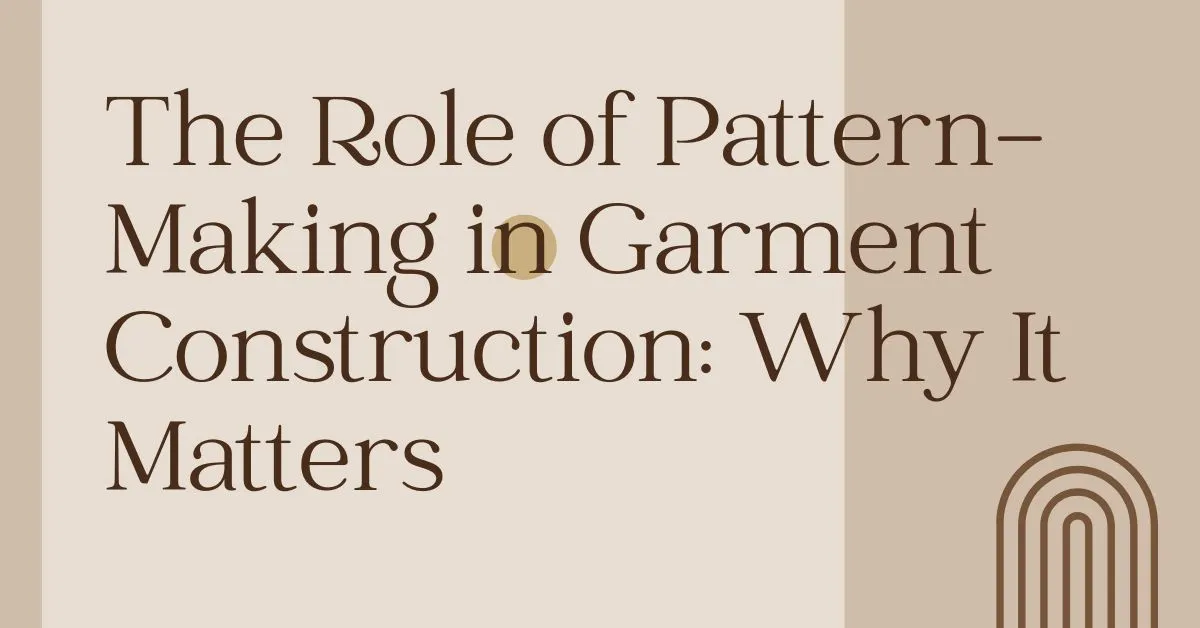Greetings future design maestros! Learn More
Have you ever gazed upon a perfectly tailored jacket,its lines sharp its fabric flowing just so,and felt that undeniable surge of inspiration? Or perhaps you’ve slipped into a dress that felt like second a skin, effortlessly flattering every curve? We often credit the designer's vision,the fabric's quality ,or even the skilled seamstress. And while all these play their part,there’s an unsung hero a silent architect, behind every garment that truly "works . " Today, we’re pulling back the curtain on this fundamental discipline: pattern-making.
As fashion design learners,you’re on a thrilling journey of creativity .You’re sketching ,dreaming envisioning garments that will one walk day the runways or grace the everyday.But between that brilliant sketch on your pad and the tangible wearable reality , lies the intricate often challenging yet immensely rewarding world of pattern-making. It’s not just a technical skill; it’s the very language your designs speak to the fabric, the bridge between your 2D vision and a breathtaking 3D reality. So let’s explore why mastering pattern making isn't just important—it's absolutely essential for your future success in garment design.
What is the Blueprint of Brilliance in Garment Construction ?
Imagine an architect designing a magnificent skyscraper. They don't just sketch a beautiful building and hope it stands. They create detailed blueprints meticulously planning every beam,every window every pipe, ensuring structural integrity , safety and aesthetic appeal. In the of world fashion the pattern is your blueprint.It's the flat,two-dimensional template that when cut from fabric and sewn together transforms into a three-dimensional garment.
Without a precise pattern , your most inspired design is merely a dream . It’s the pattern that dictates the garment's shape , its proportion its fit and how it will interact with the human body .Every curve every dart every seam allowance on that paper or digital file holds the key to your final product. It’s a language of lines notches, and symbols each conveying critical information to the cutter and sewer . This foundational understanding is what elevates a good design into a truly exceptional piece of clothing bringing your garment design visions to life with precision.
How Does 2D Transform into 3D: The Magic Unfolds?
This transformation is pure alchemy. You start with flat pieces of paper or digital shapes, seemingly abstract.But as you learn the principles of dart manipulation , slashing and spreading ,pivoting , and grading , you begin to see how these flat pieces will wrap around the complex contours of the human form . You’re essentially deconstructing a 3D object (the body) into 2D components then reversing the process with fabric. It’s a skill that requires not technical just precision but a also keen understanding of anatomy and spatial reasoning.
More Than Just Lines: The Language of Fit
A pattern isn't just about the outline of a garment; it's deeply with ingrained the DNA its of fit. The placement and size of darts, the curve a of sleeve the amount of ease (the difference between body measurement and garment measurement)—these are all determined during the pattern-making process. It's here that you decide if your dress will be body-skimming or voluminous,if your jacket will have a sharp shoulder or a relaxed dropped one. Every line speaks to how the garment will eventually sit drape,feel and on the wearer.
Why Does Garment a "Work" ?The Unseen Foundation of Fit and Form
Think about last the time you saw someone in an outfit that just didn't quite right look. Maybe the shoulders sagged, the waist was ill-defined or the fabric pulled uncomfortably.Chances are the issue originated in the pattern .A garment "works" when it achieves the designer's intended silhouette fits comfortably and drapes beautifully on the body. This synergy is directly attributable to well-executed pattern making .
I vividly remember one of my earliest projects in design school. I had this incredible vision for an asymmetrical top with dramatic gathers. My sketch was a masterpiece! But when I cut the fabric directly, based on intuition alone it was a disaster.It sagged where it should have gathered twisted where it should have flowed and simply didn't resemble my drawing.It was a harsh yet invaluable lesson: a beautiful sketch needs a precise map to become a beautiful reality . That map is the pattern. Understanding this connection is key to successful garment design.
Anatomy of a Great Fit: Precision in Every Seam
Fit is arguably the most critical element of construction garment and it is entirely dictated by the pattern. A pattern maker considers ease allowances for comfort and movement balances the pattern pieces to prevent twisting or pulling , and shapes to seams conform to the body's curves.It's about understanding how fabric behaves how gravity affects drape and how the human body moves. Without this precision, even the most luxurious can fabric look cheap and the most innovative design can fall flat.
Beyond the Body: How Patterns Shape Aesthetic
Beyond just fitting the body , patterns are instrumental in shaping the overall aesthetic and narrative of your garment. you Do want a structured architectural look ? Your pattern will incorporate precise angles and minimal ease.Are you aiming for a fluid romantic silhouette? Your pattern will likely feature bias cuts gathers and voluminous sections. The pattern is where you literally sculpt your vision translating abstract ideas like 'flow' or 'strength' into tangible form through clever manipulation of lines curves and.
From Concept to Creation: Is Your Vision Truly Communicated ?
The journey from a creative spark to a finished garment is long and collaborative . Your initial sketch is just the beginning.The pattern serves as the universal language that translates your artistic concept into actionable instructions for manufacturers,cutters and sewers . Without a clear accurate pattern misinterpretations are rampant leading to wasted time, materials and ultimately a product that doesn't match your original intent.
Imagine sending a design for production with a vague,hand-drawn pattern . The factory might interpret your design differently, resulting in a product that'too s tight, too loose , or completely off-kilter. This is where the trust built on precise pattern making comes into play. A well-drafted pattern minimizes errors,streamlines the production process , and ensures that the final garment is a faithful representation of your design .
Designer The's True Voice: Translating Inspiration
Your pattern is your true voice in the production line. It communicates every design detail from the precise of depth a pleat to the exact flare of a skirt .It’s the point where your creative inspiration meets technical execution. Investing time developing in excellent pattern-making skills means you retain control over your vision, ensuring that what you designed is what gets made. It empowers you to refine and perfect your garment design before a single stitch is sewn.
Efficiency and Economics: A Smart Investment
Beyond artistic integrity,proficient pattern making is a shrewd choice economic. Accurate patterns mean less fabric waste fewer prototypes, and reduced production errors .This translates directly into cost savings and a more sustainable design process. In the competitive world of fashion, efficiency is key, and it all starts with a perfect pattern.Think about it: every mistake on the cutting table or sewing machine costs money and time . A good pattern is investment an in your bottom line .
The Path Forward: How Can You Master This Essential Art?
So how you do, as an aspiring fashion design learner master this critical skill?It’s a journey that requires dedication , practice and a willingness to learn from every cut and seam .
Embrace the Flat Pattern: Your Foundation
with Start flat pattern drafting. Learn the fundamentals of blocks (slopers) , dart manipulation and creating basic garment components like sleeves collars and waistbands. This is the foundational knowledge that will allow you to build any design.Practice, practice practice!
Dive into Draping: Sculpting on the Form
Once you have a grasp of flat patterns explore draping.This technique involves manipulating fabric directly on a dress form allowing you to sculpt and visualize your designs in three dimensions . Draping often inspires new design lines and helps you understand how fabric behaves which in turn informs your flat pattern making.
Digital Daring: CAD and 3D Tools
Don't shy away from modern technologies. CAD (Computer-Aided Design) software for pattern making is becoming increasingly vital .Tools like Gerber Accumark, Optitex, and Clo3D allow for faster pattern adjustments, virtual sampling, and seamless integration with manufacturing . Embracing these tools will make you a more and versatile in-demand professional .
Practice Patience and Persistency: The Keys to Mastery
There will be frustrating moments ,patterns that don't quite work and designs that seem impossible to translate. But remember every expert started as a beginner. Be patient with yourself persist through the challenges ,and keep honing your skills.Join workshops find a mentor , experiment and constantly.
In conclusion pattern-making isn't just a step in garment construction; it's the very soul of it.It’s where your creative vision takes tangible form where fit is perfected and where efficiency is born .As you embark on your exciting journey in fashion embrace pattern making not as a chore but as the powerful tool that will unlock the true potential of your designs . Your future success in garment design depends on it .Now go forth and craft those blueprints of brilliance !


